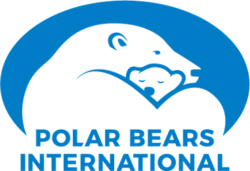Polar Bears International
Polar Bears International (PBI) is a non-profit polar bear conservation organization. Their research, education, and action programs address the issues that are endangering polar bears.[2] The organization also studies polar bears and monitors their activity data which helped lead to the animals being listed as a threatened species.[3] While Churchill, Canada, serves as an important hub for PBI scientists and educators, the organization's work on behalf of polar bears spans the Arctic including Svalbard, Russia and Alaska.
 | |
| Formation | January 1994 |
|---|---|
| Type | 501(c)(3) |
| 77-0322706[1] | |
| Headquarters | |
Executive Director | Krista Wright |
Chief Scientist | Dr. Steven C. Amstrup |
| |
Revenue (2018) | $5,972,199 |
| Expenses (2018) | $3,041,250 |
Staff (2020) | 18 |
| Website | polarbearsinternational |
PBI's Chief Scientist is Steven Amstrup,[4] winner of the 2012 Indianapolis Prize.[5]
Description
Churchill, Manitoba is known throughout the world as the place where hundreds of polar bears gather each fall to wait for the sea ice to return to Hudson Bay. The town is also a hub for Polar Bears International and several of PBI's programs including Tundra Connections webcasts[6] – free, live webcasts provided by polar bear and climate scientists and geared towards students, families and professionals, Polar Bear Cams with Explore.org, and Climate Alliance training take place.
Polar bears are marine mammals, adapted to life on frozen or partly-frozen ocean. They hunt seals from the surface of the sea ice, and also rely on the ice to travel. Sea ice is as important to the Arctic as the soil is to the forest – it supports the entire Arctic food chain. Arctic sea ice is melting at a rate of 12.8% per decade.[7] The 13 lowest Arctic sea extents on record have all occurred in the last 13 years.[8]
In partnership with Google, polar bear habitats in Churchill were added to Google Maps in February 2014.[9][10] PBI has worked with the Association of Zoos and Aquariums to create education programs regarding polar bear conservation.[11] In November 2019, PBI unveiled the Polar Bears International House,[12] a new center in Churchill.
Research
Denned polar bears are invisible under the snow; therefore winter-time petroleum exploration and development activities in northern Alaska have potential to disturb maternal polar bears and their cubs. Previous research determined forward looking infrared (FLIR) imagery could detect many polar bear maternal dens under the snow, but also identified limitations of FLIR imagery. This study evaluated the efficacy of FLIR-surveys conducted by oil-field operators from 2004–2016.[13] The study was led by Tom S. Smith of Wildlife and Wildlands Conservation Program, Brigham Young University and scientists Steven Amstrup, B. J. Kirschhoffer, and Geoffrey York of Polar Bears International.
"The ecological and behavioral significance of short-term food caching in polar bears (Ursus maritimus)" This study observes wild polar bears caching of food and has led to the conclusion that such behavior does not occur or is negligible in this species per observations of short-term hoarding by polar bears between 1973 and 2018 in Svalbard, Greenland, and Canada. [14] This study was conducted by: Ian Stirling - Wildlife Research Division, Department of Environment, Department of Biological Sciences, University of Alberta Kristin L. Laidre - Polar Science Center, Applied Physics Laboratory, University of Washington, Seattle Andrew E. Derocher - Department of Biological Sciences, University of Alberta, Edmonton Canada Rinie Van Meurs - Jastrzebia 201, 34-143 Lanckorona, Poland.
References
- "Polar Bears International, Form 990 2015". ProPublica. Retrieved 14 September 2017.
- "'We know they aren't feeding': fears for polar bears over shrinking Arctic ice". The Guardian. 29 September 2019. Retrieved 10 February 2020.
- Kaufman, Mark (20 November 2019). "Village of the Sea Bears". Mashable. Retrieved 10 February 2020.
- "Introducing Dr. Steven Amstrup, Polar Bear Expert and 2014 Expo Guest Speaker". Wildlife Conservation Network. 6 August 2014. Retrieved 2 March 2018.
- "The 2012 Indianapolis Prize Winner". Indianapolis Prize. Retrieved 2 March 2018.
- "Tundra Connections Webcasts - Polar Bears International". polarbearsinternational.org. Retrieved 25 March 2020.
- "Arctic Sea Ice Minimum". NASA. Retrieved 10 February 2020.
- "Arctic sea ice plunges to dismal levels". Mashable. Retrieved 10 February 2020.
- "Street View Treks: Churchill, Canada". Google Maps.
- Explore the Polar Bear Capital of the World with Google Maps. 27 February 2014. Retrieved 11 March 2018.
- "Executive Summary of AZA's Partnership with Polar Bears International". Association of Zoos and Aquariums. Retrieved 11 March 2018.
- "'Polar Bears International unveils the Polar Bears International House, a landmark educational interpretive centre in Churchill". Bloomberg. 4 November 2019. Retrieved 10 February 2020.
- Smith, Tom S.; Amstrup, Steven C.; Kirschhoffer, John; York, Geoffrey (9 September 2019). "Efficacy of aerial forward-looking infrared surveys for detecting polar bear maternal dens". bioRxiv: 763144. doi:10.1101/763144. Retrieved 25 March 2020.

- Stirling, Ian; Laidre, Kristen; Derocher, Andrew; Van Meurs, Rinie (12 November 2020). "The ecological and behavioral significance of short-term food caching in polar bears(Ursus maritimus)". Nrcresearch. 6: 41–52. doi:10.1139/as-2019-0008.This work is licensed under a Creative Commons Attribution 4.0 International License Creative Commons Attribution 4.0 International License.